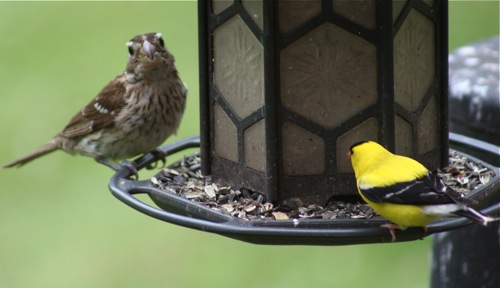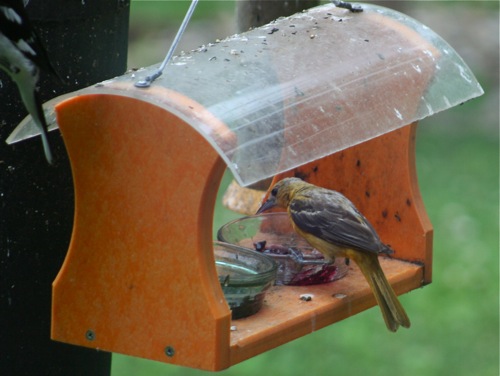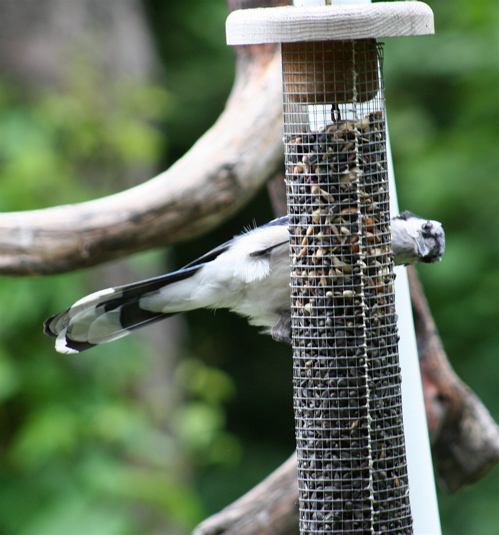 Like rambunctious kids at a restaurant, young birds are learning the ropes at Mr. Neil's feeders. Above is a female rose-breasted grosbeak who I thought was an adult female, but she engaged in some begging behavior with a male and sat for awhile on the pole above the feeder watching the other birds feed, working out how to do it. Most of the adult females know how to feed--they are all business when they come to the feeder. They perch on a branch, make sure the coast is clear of predators, land on the pole, take another look and then jump right down to the feeders. This one seemed unsure of how the food came out of the feeder or what to make of the smaller birds around her.
Like rambunctious kids at a restaurant, young birds are learning the ropes at Mr. Neil's feeders. Above is a female rose-breasted grosbeak who I thought was an adult female, but she engaged in some begging behavior with a male and sat for awhile on the pole above the feeder watching the other birds feed, working out how to do it. Most of the adult females know how to feed--they are all business when they come to the feeder. They perch on a branch, make sure the coast is clear of predators, land on the pole, take another look and then jump right down to the feeders. This one seemed unsure of how the food came out of the feeder or what to make of the smaller birds around her.
This young oriole ate some of the grape jelly, but also made a haphazard landing on the thistle feeder and took a few pecks at the feeding port. I'm sure it had been watching the goldfinches and thought, "Well, if those dudes are getting food out of there, I'm sure I can too."
And much the same way I felt about catfish, thought to itself, "Seriously? You think this is good? Bleh!"
Here's a recently fledged red-bellied woodpecker. They're just so awkward and bald (bald in the sense that they have no read on their heads, not that they are missing feathers). The suet log was empty and he was watching another red-belly perched on a peanut feeder and wondering if it has the landing skills necessary to be able to land on the nut feeder too. This young bird was very nervous and seemed a poster child for hawk bait. It was continually begging in the trees, following the parent birds (who were over feeding it at this point) and then made all kinds of strange loud squawks as it flew. I'm sure it's saying, "I don't know what I'm doing, why is this happening to me? How to I move, I'm hungary, aaaaaaaaaaaaaaaaah!"
Of all the boisterous youngsters visiting the feeders, the blue jays were the most refined diner. I love this photo, I was shooting from the kitchen window and the young blue eyed me warily wonder what that sound was (and why my lens was aimed at it).
I have mixed feelings going through the woods right now. Some birds have finished their territory songs for the season, others are going for a second brood, some are just getting started, but six months from now, the sounds at the feeder and in the wood will be softer, occasional caws of crows, sweet contact notes of chickadees, a few laughs of nuthatches.
I wonder if the winter birds enjoy the quiet of winter without having young birds crashing around at the feeders...the rowdy college kids leave the woods leaving all who stay with a peaceful neighborhood until the next breeding season.















 This feeder is new, it's made of recycled plastic and has two dishes for grape jelly and mealworms. It also holds two orange halves. I like it because recycled plastic lasts for a long time and the color really gets the orioles' attention. The roof keeps the jelly from turning to soup. It's been our most popular oriole feeder at the store too. It's odd, when I saw it at Bird Watch America last January, I thought it was a neat idea, but I had no clue that it would be so popular a feeder this year.
This feeder is new, it's made of recycled plastic and has two dishes for grape jelly and mealworms. It also holds two orange halves. I like it because recycled plastic lasts for a long time and the color really gets the orioles' attention. The roof keeps the jelly from turning to soup. It's been our most popular oriole feeder at the store too. It's odd, when I saw it at Bird Watch America last January, I thought it was a neat idea, but I had no clue that it would be so popular a feeder this year. According to
According to